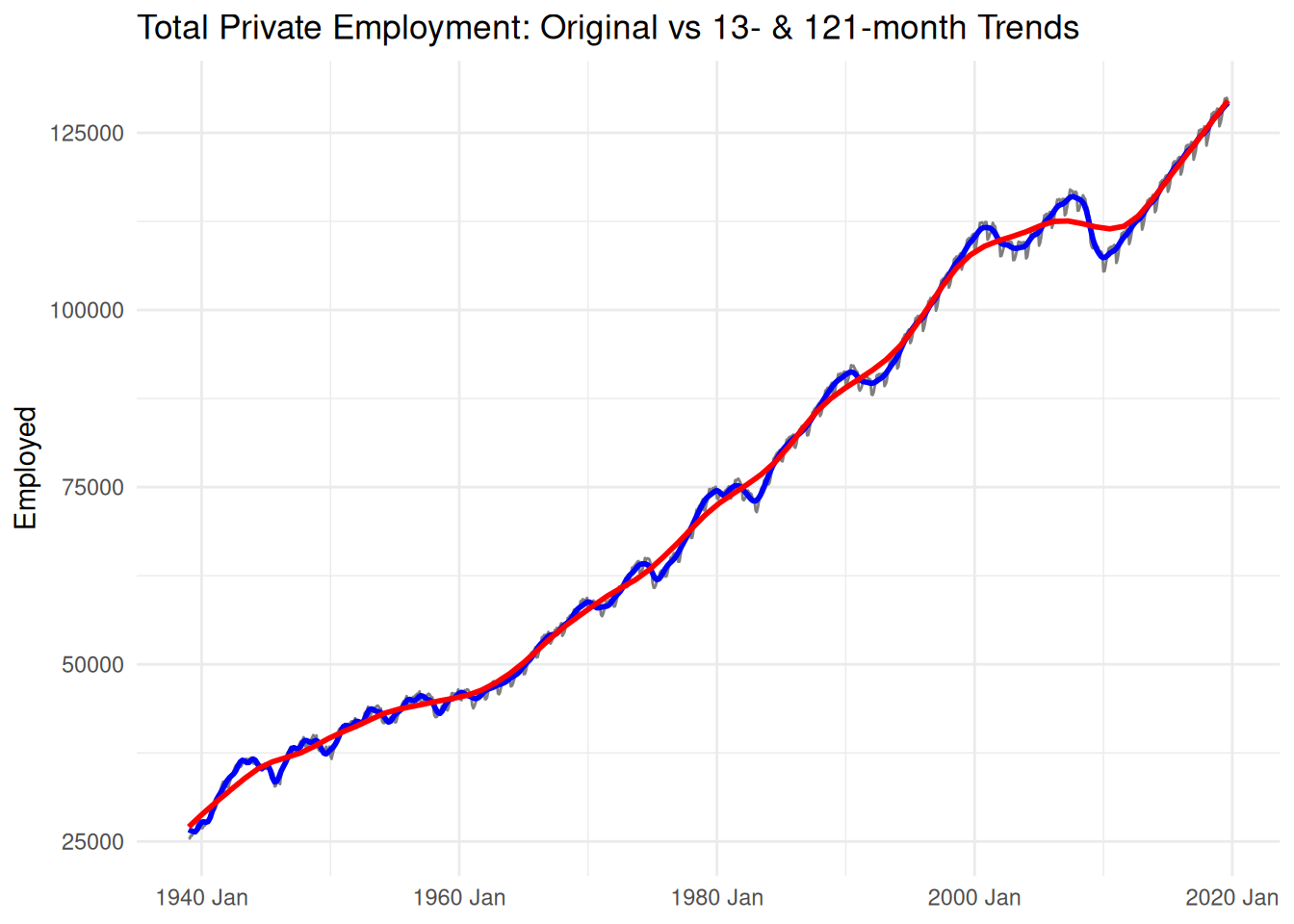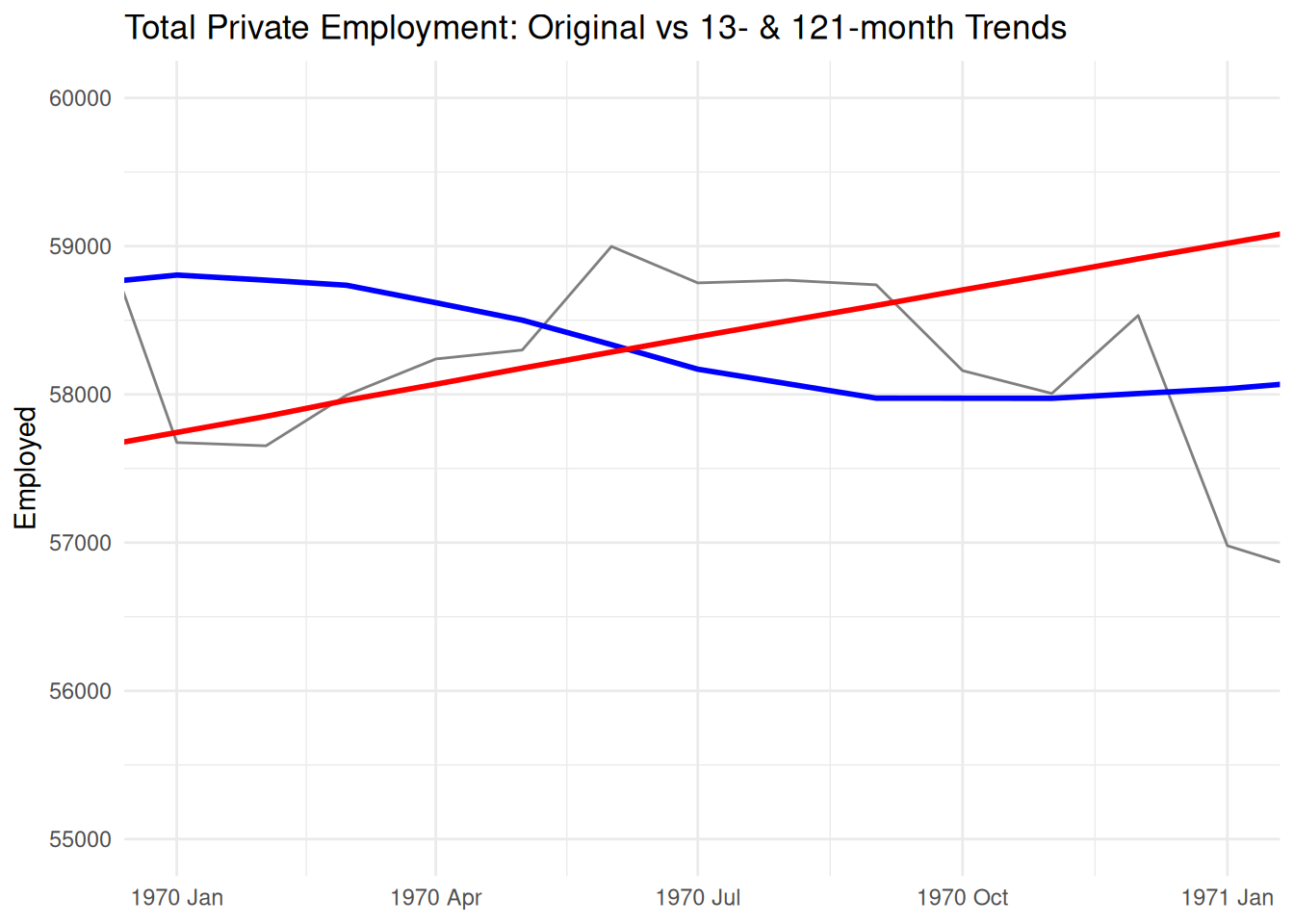start_date <- "2010-01-01"
end_date <- Sys.Date()
# Get data from Yahoo Finance
getSymbols("^GSPC", src = "yahoo",
from = start_date,
to = end_date,
auto.assign = TRUE) %>% invisible()Activity51
Ethical Considerations in Time Series Analysis
# Extract Adjusted Close prices and convert to tsibble
sp500_ts_scratch <- GSPC %>%
Ad() %>% # Select Adjusted Close column
`colnames<-`("Adjusted_Close") %>% # Rename column
fortify.zoo(names = "Date") %>% # Convert zoo object to data frame
as_tsibble(index = Date) %>%
# Calculate log returns
mutate(Log_Return = difference(log(Adjusted_Close))) %>%
drop_na(Log_Return) %>%
fill_gaps(.full = TRUE) %>%
mutate(Log_Return = na.approx(Log_Return)) 1. Data Integrity & Transparency
1.1 The Myth of Complete Data
Concept: All real-world time series contain gaps/imputation needs
Example: S&P 500 data:
sp500_ts <- GSPC %>%
Ad() %>%
`colnames<-`("Adjusted_Close") %>% # rename
fortify.zoo(names = "Date") %>% # to data.frame
as_tsibble(index = Date) %>% # to tsibble
fill_gaps() %>% # explicit missing days
mutate(Adjusted_Close = na.approx( # interpolate prices
Adjusted_Close, rule = 2 # rule=2: carry ends
)) %>%
mutate(Log_Return = difference(log(Adjusted_Close))) sp500_ts_scratch <- GSPC %>%
Ad() %>% # Select Adjusted Close column
`colnames<-`("Adjusted_Close") %>% # Rename column
fortify.zoo(names = "Date") %>% # Convert zoo object to data frame
as_tsibble(index = Date) %>%
mutate(Log_Return = difference(log(Adjusted_Close))) Ethical Implications:
- 🚨 Silent imputation creates false continuity
- 📉 Hidden assumptions about market behavior
- 💡 Always report gap treatment methods (use
imputeTS::na_ma()as alternative)
Visual Evidence:
sp500_ts_plot <- GSPC %>%
Ad() %>% `colnames<-`("Adjusted_Close") %>% # rename
fortify.zoo(names="Date") %>%
as_tsibble(index=Date) %>%
fill_gaps() %>%
mutate(Log_Return = log(Adjusted_Close) - log(lag(Adjusted_Close)))
weekend_periods <- sp500_ts_plot %>%
distinct(Date) %>%
filter(wday(Date) %in% c(1,7)) %>% # Sunday=1, Saturday=7
arrange(Date) %>%
mutate(grp = cumsum(c(1, diff(as.numeric(Date)) != 1))) %>%
group_by(grp) %>%
summarise(
start = min(Date), # start at Sat midnight
end = max(Date) + days(1) # end at Mon midnight
) %>%
ungroup()
library(scales)
ggplot(sp500_ts_plot, aes(Date, Log_Return)) +
# (your weekend‐shade / rug / line layers here)
geom_rect(
data = weekend_periods,
aes(xmin = start, xmax = end, ymin = -Inf, ymax = Inf),
inherit.aes = FALSE, fill = "grey80", alpha = 0.4
) +
geom_line(color = "red", na.rm = TRUE) +
# 1. Restrict x-axis to Jan 1 2023 – Feb 28 2023
scale_x_date(
limits = as.Date(c("2023-01-01","2023-02-28")),
date_breaks = "2 weeks",
date_labels = "%b %d"
) +
# 2. Force plain numeric y labels (no 1e-notation) with three decimals
scale_y_continuous(
labels = number_format(
accuracy = 0.001,
big.mark = ",",
decimal.mark = "."
)
) +
labs(
title = "S&P 500 Log-Returns (2023 Q1)",
x = NULL,
y = "Log Return"
) +
theme_minimal()
# --- Get US Unemployment Rate Data from FRED ---
start_date <- "1948-01-01"
end_date <- Sys.Date()
# Get data (UNRATE is the series ID for Civilian Unemployment Rate, Seasonally Adjusted)
getSymbols("UNRATE",
src = "FRED",
from = start_date,
to = end_date,
auto.assign = TRUE) %>% invisible()# Convert to tsibble
unrate_ts <- UNRATE %>%
fortify.zoo(names = "Date") %>% # Convert zoo to data frame
# Ensure Date is Date class, create yearmonth index
mutate(Month = yearmonth(Date)) %>%
# Declare tsibble object
as_tsibble(index = Month) %>%
# Select relevant columns (rename UNRATE)
select(Month, Unemployment_Rate = UNRATE)1.2 Seasonality Manipulation
Concept: Seasonal adjustment choices impact policy decisions
Example: Unemployment Rate STL:
stl_decomp_unrate <- unrate_ts %>%
model(
stl_decomp = STL(Unemployment_Rate ~ trend(window = 121) +
season(window = "periodic"),
robust = TRUE)
) %>%
components() Ethical Risks:
- 🔍 Window size (121 months) smooths business cycles
- 📈 Different windows alter recession interpretations
- 💡 Document parameter sensitivity using
fabletools::refit()
Visual Proof:
stl_decomp_unrate %>%
autoplot() +
labs(subtitle="10-year Window Smoothing of Unemployment Trends")
2. Model Accountability & Impact
2.1 Assumptions and Errors
Concept: Each transformation propagates errors
Case Study: Log Returns Pipeline:
library(imputeTS)
sp500_clean <- sp500_ts %>%
# Remove non-trading days (weekends/holidays)
filter(!is.na(Adjusted_Close)) %>%
# Calculate log returns on valid trading days
mutate(Log_Return = difference(log(Adjusted_Close))) %>%
# Fill only actual trading day gaps (rare cases like exchange closures)
fill_gaps(.full = FALSE) %>%
# Ethical imputation with constraints
mutate(
Log_Return = na_locf(Log_Return, maxgap = 1) %>% # Carry forward 1 day
na_kalman() %>% # State-space imputation
na.omit() # Remove leading NA
)Ethical Chain:
- Logarithmic compression hides volatility scale
- Linear interpolation assumes market continuity
- Smoothing erases flash crash evidence
Solution: UseimputeTS::na_kalman()for state-aware imputation
2.2 Non-Stationarity
Concept: Persistent series create false narratives
Unemployment ACF Analysis:
unrate_ts %>% gg_tsdisplay(Unemployment_Rate, plot_type="partial")
Dangers:
- Slow ACF decay (ρ₁=0.98) suggests structural persistence
- Mistaking hysteresis for mean-reversion
- 💣 Policy models might assume reversibility incorrectly
Remedies:
unrate_ts %>%
features(Unemployment_Rate, unitroot_kpss) %>%
knitr::kable(caption="Stationarity Test Results")| kpss_stat | kpss_pvalue |
|---|---|
| 0.9870803 | 0.01 |
2.3 Temporal Aggregation Bias
Concept: Frequency choices shape narratives
Contrast:
# Daily vs Monthly Returns
sp500_daily <- sp500_ts %>% index_by(Date)
sp500_monthly <- sp500_ts %>% index_by(Month=yearmonth(Date)) %>%
summarise(Volatility = sd(Log_Return, na.rm=TRUE))Ethical Dimensions:
- 📅 Daily data shows volatility clusters
- 📆 Monthly aggregates hide flash crashes
- 💡 Use
tsibble::index_by()consciously
Ethical Framework Checklist
ethical_checklist <- tibble(
Step = c("Data Collection", "Gap Treatment", "Transformation",
"Model Selection", "Interpretation"),
Questions = c(
"Source transparency?",
"fill_gaps()/na.approx() documentation?",
"Log/Sqrt transforms justified?",
"Parameter sensitivity tested?",
"Uncertainty intervals provided?")
)
knitr::kable(ethical_checklist)| Step | Questions |
|---|---|
| Data Collection | Source transparency? |
| Gap Treatment | fill_gaps()/na.approx() documentation? |
| Transformation | Log/Sqrt transforms justified? |
| Model Selection | Parameter sensitivity tested? |
| Interpretation | Uncertainty intervals provided? |
Activities
Seasonality Manipulation & Model Sensitivity on us_employment
1.1 STL Window‐Choice and Its Policy Implications
# 1. Prepare series
empl_ts <- us_employment %>%
filter(Title == "Total Private") %>%
select(Month, Employed) %>%
as_tsibble(index = Month)
# 2. Fit two STLs with different season windows
stl_short <- empl_ts %>% model(STL(Employed ~ trend(window=13) + season(window="periodic")))
stl_long <- empl_ts %>% model(STL(Employed ~ trend(window=121) + season(window="periodic")))
decomp_short <- components(stl_short)
decomp_long <- components(stl_long)Tasks
1. Plot the two trend components side by side (use autoplot(decomp_… , series="trend")).
2. Overlay the original series with each smoothed trend to see how “cycle smoothing” differs.
3. Discuss in writing:
• How a 13-month vs 121-month window would affect decisions about recessions or stimulus timing.
• Which choice feels more “transparent,” and what you’d need to report to a policymaker.# 1. Side‐by‐side trend plots
trend_short <- decomp_short %>% select(Month, trend)
trend_long <- decomp_long %>% select(Month, trend)
p_short <- ggplot(trend_short, aes(Month, trend)) +
geom_line() +
labs(title="13-month STL Trend", y="Trend")
p_long <- ggplot(trend_long, aes(Month, trend)) +
geom_line() +
labs(title="121-month STL Trend", y="Trend")
library(gridExtra)
grid.arrange(p_short, p_long)
# 2. Overlay original series with both trends
empl_with_trends <- empl_ts %>%
left_join(trend_short, by="Month") %>%
rename(trend_short = trend) %>%
left_join(trend_long, by="Month") %>%
rename(trend_long = trend)
ggplot(empl_with_trends, aes(Month, Employed)) +
geom_line(color="gray50") +
geom_line(aes(y=trend_short), color="blue", size=1) +
geom_line(aes(y=trend_long), color="red", size=1) +
labs(
title="Total Private Employment: Original vs 13- & 121-month Trends",
y="Employed", x=NULL
) +
theme_minimal()
# Zoomed-in plot
ggplot(empl_with_trends, aes(Month, Employed)) +
geom_line(color="gray50") +
geom_line(aes(y=trend_short), color="blue", size=1) +
geom_line(aes(y=trend_long), color="red", size=1) +
labs(
title="Total Private Employment: Original vs 13- & 121-month Trends",
y="Employed", x=NULL
) +
coord_cartesian(xlim = yearmonth(c("1970 Jan", "1971 Jan"))) +
scale_y_continuous(limits = c(55000, 60000))+
theme_minimal()
Overlaid plot
# 1. Full‐series plot
p_main <- ggplot(empl_with_trends, aes(x = Month)) +
geom_line(aes(y = Employed, color = "Original")) +
geom_line(aes(y = trend_short, color = "13-month Trend")) +
geom_line(aes(y = trend_long, color = "121-month Trend")) +
scale_color_manual(
name = "Series",
values = c(
"Original" = "grey40",
"13-month Trend" = "purple",
"121-month Trend" = "lightblue"
)
) +
labs(
title = "Total Private Employment: Original vs 13- & 121-month Trends",
y = "Employed", x = NULL
) +
theme_minimal() +
theme(
axis.text.x = element_text(angle = 45, hjust = 1),
legend.position = "bottom",
legend.direction = "horizontal"
)
# 2. Zoomed‐in plot
p_inset <- ggplot(empl_with_trends, aes(x = Month)) +
geom_line(aes(y = Employed), color = "grey50") +
geom_line(aes(y = trend_short), color = "purple", size = 1) +
geom_line(aes(y = trend_long), color = "lightblue", size = 1) +
coord_cartesian(
xlim = yearmonth(c("2006 May", "2012 Jan")),
ylim = c(100000, 120000)
) +
labs(x = NULL, y = NULL) +
theme(
legend.position = "none",
axis.text.x = element_text(angle = 45, hjust = 1),
) +
ggthemes::theme_tufte()
# 3. Combine with cowplot
library(cowplot)
combined <- ggdraw() +
draw_plot(p_main) +
draw_plot(p_inset, x = 0.10, y = 0.45, width = 0.35, height = 0.35)
combined